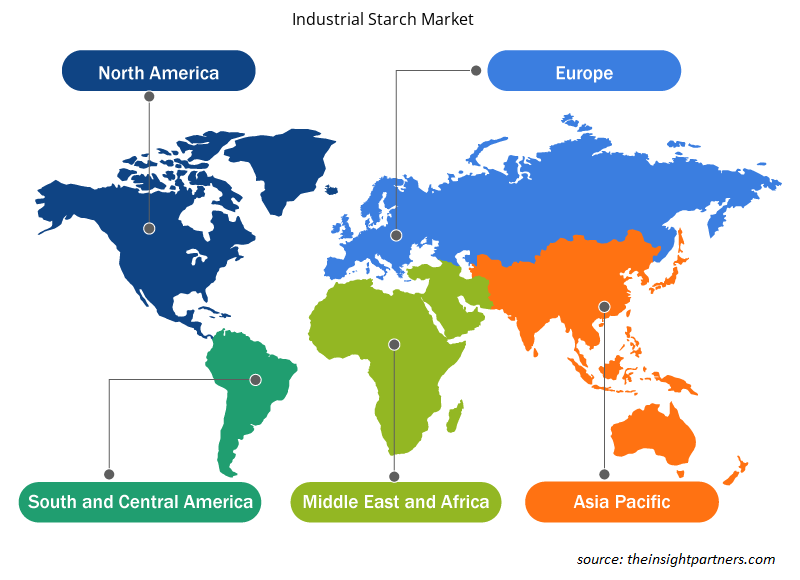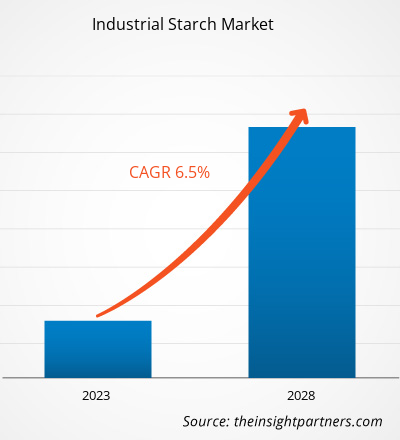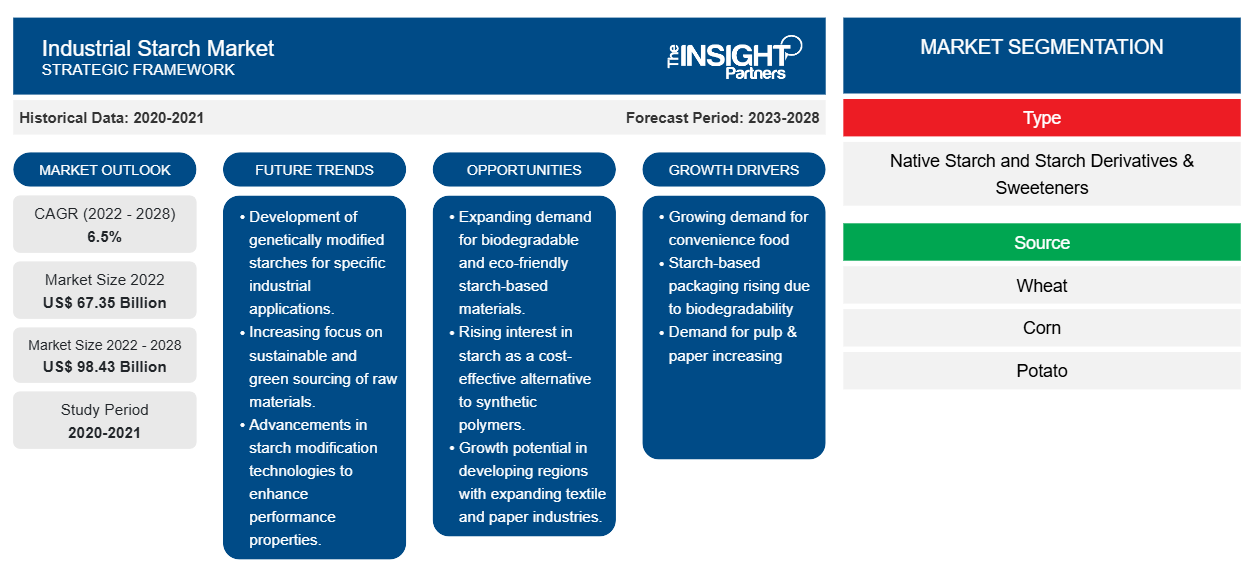[Informe de investigación] Se espera que el mercado de almidón industrial crezca de US$ 67.353,01 millones en 2022 a US$ 98.426,74 millones en 2028; se estima que crecerá a una CAGR del 6,5% entre 2022 y 2028.
El almidón es un carbohidrato complejo derivado del trigo, el maíz, la patata, la tapioca y el arroz. Es una gran fuente de energía. El almidón es un agente espesante/gelificante y estabilizador en una amplia gama de alimentos y bebidas, incluidos productos de panadería y confitería, sopas, salsas, postres helados, cremas lácteas y bebidas listas para beber. La demanda de alimentos preparados está aumentando a nivel mundial debido al agitado estilo de vida de los consumidores y al alto ingreso per cápita. Además, los envases de alimentos a base de papel necesitan un revestimiento para evitar que el agua o el oxígeno penetren en el envase y estropeen el alimento que contiene. Por lo general, este revestimiento protector se fabrica a partir de plástico derivado del petróleo. Sin embargo, los fabricantes están adoptando materias primas de origen biológico y ecológicas para el revestimiento de envases de alimentos a base de papel, ya que cada vez son más conscientes del impacto negativo del plástico derivado del petróleo en el medio ambiente. Las características de los envases a base de almidón, como la biodegradabilidad y la asequibilidad, están impulsando su popularidad entre los fabricantes.
En los últimos años, la demanda de almidón en la industria de la pulpa y el papel ha crecido significativamente con la ampliación de las operaciones en esta industria. La floreciente industria del comercio electrónico contribuye significativamente a la demanda de cartones ondulados. Además, un cambio notable hacia envases sin plástico para garantizar la sostenibilidad medioambiental está impulsando la demanda de materiales de embalaje sostenibles. Según una investigación realizada por Roquette Frères, el consumo de almidón industrial en la fabricación de cartón ondulado aumentó un 6% en 2020 debido al aumento significativo del sector del comercio electrónico en medio de la pandemia de COVID-19. Por tanto, la creciente demanda de almidón en la industria del papel y el cartón está impulsando el mercado del almidón industrial.
Personalice este informe según sus necesidades
Obtendrá personalización en cualquier informe, sin cargo, incluidas partes de este informe o análisis a nivel de país, paquete de datos de Excel, así como también grandes ofertas y descuentos para empresas emergentes y universidades.
-
Obtenga las principales tendencias clave del mercado de este informe.Esta muestra GRATUITA incluirá análisis de datos, desde tendencias del mercado hasta estimaciones y pronósticos.
Los fabricantes de todo el mundo se están beneficiando del crecimiento de la industria del comercio electrónico. En todo el mundo, varios fabricantes y canales de comercio electrónico están promoviendo el uso de materiales de embalaje sostenibles y ecológicos. Se espera que el crecimiento del mercado del almidón industrial se impulse con esta creciente adopción de materiales de embalaje sostenibles por parte de la industria del comercio electrónico. Las empresas de comercio electrónico indias Myntra y Flipkart han adoptado medidas para reducir o eliminar el uso de plástico de un solo uso en sus materiales de embalaje. Además, se espera que las políticas gubernamentales para reducir la contaminación plástica impulsen la demanda de almidón industrial.benefitting from the growth of the e-commerce industry. Across the globe, various manufacturers and e-commerce channels are promoting the use of sustainable and eco-friendly packaging materials. The industrial starch market growth is expected to boost with this increasing adoption of Myntra and Flipkart have adopted to reduce or eliminate the use of single-use plastic in their packaging materials. Moreover, government policies to reduce plastic pollution is expected to boost the demand for industrial starch.
Perspectivas del mercado
El amplio alcance de aplicación del almidón industrial impulsa el crecimiento del mercado
La gama de aplicaciones de los almidones industriales en diversas industrias de uso final se ha ampliado en los últimos años. Se utilizan como espesantes, gelificantes y aglutinantes en una amplia gama de alimentos y bebidas, incluidos productos de panadería, sopas y aderezos para ensaladas, confitería, salsas, helados , bebidas de frutas y productos lácteos. El almidón también se utiliza en aplicaciones no alimentarias, como pulpa y papel, productos farmacéuticos y piensos para animales. En la industria farmacéutica, el almidón se utiliza como excipiente y aglutinante en la fabricación de comprimidos. Además, los materiales a base de almidón son una solución perfecta para los materiales de envasado de alimentos biodegradables que ayudan a reducir la contaminación ambiental.excipient and binding agent in tablet making. Moreover, starch-based materials are a perfect solution for biodegradable food packaging materials that help to reduce environmental pollution.
Tipo de información
Según el tipo, el mercado de almidón industrial se segmenta en almidón nativo y derivados de almidón y edulcorantes. En 2021, el segmento de derivados de almidón y edulcorantes dominó el mercado. La creciente demanda de alimentos y bebidas, debido al aumento de los niveles de ingresos disponibles y al aumento de la población mundial, y el uso de derivados de almidón en las industrias de alimentos y bebidas es el motor de crecimiento más importante para el segmento de derivados de almidón del mercado de almidón industrial.
Entre los actores clave que operan en el mercado del almidón industrial se encuentran Agrana Beteiligungs-AG; ADM; Ingredion Incorporated; Roquette Frères; Tereos Group; Cargill, Incorporated; Tate & Lyle PLC; Grain Processing Corporation; Royal Cosun; y AVEBE. Los principales actores adoptan varias estrategias, como fusiones y adquisiciones y lanzamientos de productos, para expandir su presencia geográfica y su base de consumidores. Beteiligungs-AG; ADM; Ingredion Incorporated; Roquette Frères; Tereos Group; Cargill, Incorporated; Tate & Lyle PLC; Grain Processing Corporation; Royal Cosun; and AVEBE are among the key players operating in the industrial starch market. The leading players adopt several strategies, such as mergers & acquisitions and product launches, to expand their geographic presence and consumer base.
Informe Destacado
- Tendencias progresivas en la industria del almidón industrial para ayudar a los actores a desarrollar estrategias efectivas a largo plazo
- Estrategias de crecimiento empresarial adoptadas por las empresas para asegurar el crecimiento en los mercados desarrollados y en desarrollo
- Análisis cuantitativo del mercado mundial de almidón industrial de 2021 a 2028
- Estimación de la demanda de almidón industrial en diversas industrias
- Análisis de las cinco fuerzas de Porter para ilustrar la eficacia de los compradores y proveedores que operan en la industria del almidón industrial
- Desarrollos recientes para comprender el escenario competitivo del mercado y la demanda de almidón industrial
- Tendencias y perspectivas del mercado junto con los factores que rigen el crecimiento del mercado del almidón industrial
- Comprensión de las estrategias que sustentan el interés comercial frente al crecimiento del mercado, ayudando en el proceso de toma de decisiones.
- Tamaño del mercado de almidón industrial en varios nodos del mercado
- Descripción detallada y segmentación del mercado, así como de su dinámica industrial.
- Tamaño del mercado de almidón industrial en varias regiones con oportunidades de crecimiento prometedoras
Perspectivas regionales del mercado del almidón industrial
Los analistas de Insight Partners explicaron en detalle las tendencias y los factores regionales que influyen en el mercado del almidón industrial durante el período de pronóstico. Esta sección también analiza los segmentos y la geografía del mercado del almidón industrial en América del Norte, Europa, Asia Pacífico, Oriente Medio y África, y América del Sur y Central.

- Obtenga los datos regionales específicos para el mercado de almidón industrial
Alcance del informe sobre el mercado del almidón industrial
| Atributo del informe | Detalles |
|---|---|
| Tamaño del mercado en 2022 | US$ 67.35 mil millones |
| Tamaño del mercado en 2028 | US$ 98,43 mil millones |
| CAGR global (2022-2028) | 6,5% |
| Datos históricos | 2020-2021 |
| Período de pronóstico | 2023-2028 |
| Segmentos cubiertos |
Por tipo
|
| Regiones y países cubiertos |
América del norte
|
| Líderes del mercado y perfiles de empresas clave |
|
Densidad de los actores del mercado del almidón industrial: comprensión de su impacto en la dinámica empresarial
El mercado de almidón industrial está creciendo rápidamente, impulsado por la creciente demanda de los usuarios finales debido a factores como la evolución de las preferencias de los consumidores, los avances tecnológicos y una mayor conciencia de los beneficios del producto. A medida que aumenta la demanda, las empresas amplían sus ofertas, innovan para satisfacer las necesidades de los consumidores y aprovechan las tendencias emergentes, lo que impulsa aún más el crecimiento del mercado.
La densidad de actores del mercado se refiere a la distribución de las empresas o firmas que operan dentro de un mercado o industria en particular. Indica cuántos competidores (actores del mercado) están presentes en un espacio de mercado determinado en relación con su tamaño o valor total de mercado.
Las principales empresas que operan en el mercado del almidón industrial son:
- AGRANA Beteiligungs AG (Asociación de Empresas Agranas)
- ADM
- Ingredion Incorporated
- Hermanos Roquette
- Grupo Tereos
Descargo de responsabilidad : Las empresas enumeradas anteriormente no están clasificadas en ningún orden particular.

- Obtenga una descripción general de los principales actores clave del mercado de almidón industrial
El "Análisis del mercado del almidón industrial hasta 2028" es un estudio especializado y profundo de la industria de productos químicos y materiales, que se centra en el análisis de las tendencias del mercado. El informe tiene como objetivo proporcionar una descripción general del mercado con una segmentación detallada. El mercado del almidón industrial está segmentado en función del tipo, la fuente, la aplicación y la geografía. Según el tipo, el mercado del almidón industrial se segmenta en almidón nativo y derivados del almidón y edulcorantes. Según la fuente, el mercado se segmenta en trigo, maíz, patata, mandioca y otros. Según la aplicación, el mercado se segmenta en alimentos y bebidas, pulpa y papel, piensos, productos farmacéuticos y otros. Según la geografía, se segmenta en cinco regiones principales: América del Norte, Europa, Asia Pacífico, Oriente Medio y África, y América del Sur y Central. En 2021, Asia Pacífico dominó el mercado del almidón industrial.
- Análisis histórico (2 años), año base, pronóstico (7 años) con CAGR
- Análisis PEST y FODA
- Tamaño del mercado, valor/volumen: global, regional y nacional
- Industria y panorama competitivo
- Conjunto de datos de Excel
Informes recientes
Testimonios
Razón para comprar
- Toma de decisiones informada
- Comprensión de la dinámica del mercado
- Análisis competitivo
- Información sobre clientes
- Pronósticos del mercado
- Mitigación de riesgos
- Planificación estratégica
- Justificación de la inversión
- Identificación de mercados emergentes
- Mejora de las estrategias de marketing
- Impulso de la eficiencia operativa
- Alineación con las tendencias regulatorias























 Obtenga una muestra gratuita para - Mercado de almidón industrial
Obtenga una muestra gratuita para - Mercado de almidón industrial